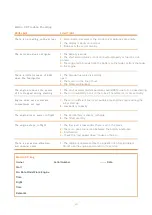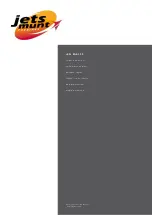
Engine Description
The engine is a turbojet of a single shaft design specifically designed to power RC aircraft.
The engine starts automatically thanks to an installed electric starter situated in the front.
The starting sequence is controlled by an electronic unit that initiates the starting sequence and controls the
parameters of the engine within the design limits.
The engine uses a system of direct liquid preheating, ignited by a long life ceramic glow plug situated inside the
engine. After the initial preheat the liquid fuel is gradually introduced. The fuel should contain a small percentage
(4%) of oil and uses part of this fuel to lubricate its two ceramic high speed bearings.
The fuel for the engine is provided from a fuel tank through a small electrical pump. The engine speed between
idle and maximum are controlled by varying the speed of the fuel pump through an electronic controller called an
ECU (electronic control unit).
Installation Notes
1.
The engine should be mounted using the strap mount supplied or an approved equivalent.
2.
The temperature probe should be firmly fixed to the engine as supplied and not allowed to rattle against metal
parts as this could result in radio interference.
3.
The signal cables from the engine must be carefully routed away from the engine intake so there is no
possibility of accidental ingestion of the wire.
4.
Fuel and starting pipes should be routed similarly clear of the intake.
The engine must not be run with
the starting pipe open to the atmosphere.
5.
The fuel pump should be mounted at least 100 mm away from the front of the engine. The pump can emit
magnetic pulses that cause the speed sensor to transmit incorrect rpm information to the ECU. The fuel pump
should be preferably mounted with the spindle in the vertical position with the motor uppermost. In the event of
any fuel seeping from the pump this will not pass through the electric motor.
Note the pump is supplied fitted
with built in suppression to reduce radio frequency noise.
6.
The center of the fuel tank should be mounted laterally, as near to the center of gravity (CofG) of the model as
possible. This will minimize the C of G shift as the fuel is used during flight.
7.
Any air ducting to the inlet of the engine must have a minimum area of 40cm2 equivalent to a 65 mm (2-1/2”)
square.
8.
If an extended exhaust duct is required, it should be approved by Jets-Munt SL. We have found that an exhaust
of 65 mm diameter gives optimum engine performance.
9.
Extreme care should be exercised to ensure that no foreign object, loose parts of the model, or debris are
allowed to enter the compartment where the engine is installed.
We recommend testing the engine on a test stand prior airframe installation.
You should have a clear idea of how to arrange the components needed to run the engine inside the model. The
main issue is the fuel tank, you will need to arrange the C of G in the centre of the tank and adjust the receiver
and ECU batteries to achieve the correct location.
Do not be tempted to move the fuel pump into the area between the tank and the engine as this can cause
interference with the rpm pickup and presents a potential hazard in event of fuel leaking from the pump.
In the event of the temperature probe wire being too short, it is correct to extend this with a good quality servo
extension lead – use a gold plated connector version. With this arrangement a error of around 10°C is
sometimes seen on the temperature display but this is of no consequence in normal starting and running.
4


















